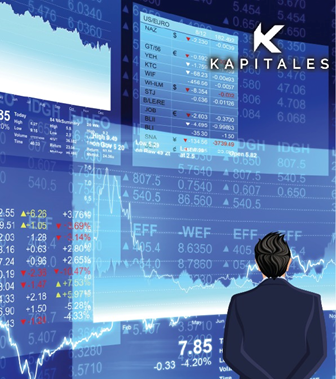What is primary and secondary market?
A primary market is a place where new stocks or bonds are sold to the public for the first time. This market is also called the new issues market. Most commonly, the new issues take the form of an IPO. Primary markets are facilitated by underwriting groups comprising investment banks that set the initial price range for a given security and manage its sale to investors. Once the initial sales are completed, the subsequent trading is conducted on the secondary market.
In the secondary market, a broker purchases securities on behalf of investors. Small investors get the opportunity to trade as they are excluded from the IPO. Investors trade the previously issued shares and the price of each stock is decided based on the demand and supply of the particular asset class.
What is OTC market?
In the OTC (over the counter) market, securities are traded between the counterparties, and there is no involvement of exchange in this process. The trading through OTC is facilitated either by a broker or a dealer specialising in OTC markets.
Generally, stocks that trade on the OTC market are stocks of small companies that cannot meet the exchange’s listing requirements.
What is a bull market?
A bull market refers to a market that is on the rise, and the economy is sound. In bull, the investors are optimistic that the stock or the industry is poised to move up in the coming period. Investors adopting the bull approach believe that the market will move up, and they can make more profits by selling them at a later stage.
Some of the characteristics of bull market include:
- An extended period of rising stock price.
- Strong and strengthening economy.
- Strong investor confidence.
- Positive outlook of the company and the industry.
What is a bear market?
Some characteristics of bear market include
- Market has dropped 20% or above from previous highs.
- Investors panic and are seen pessimistic.
- General economy of the country is not good.
- Stock value goes down.
- Companies’ profits are impacted.
A bear market is just the opposite of a bull market. In a bear market, investors are pessimistic with respect to any stock or the broader market. They believe that the prices will go down in the coming period. In such an environment, bearish investors tend to take short positions and make a profit.
Bearish market sentiment can be applied to all market types like commodity, stock, and bond markets. Technically, many experts say that a bear market happens when the underlying asset’s price drops 20% or even more than that from its recent highs.
What is market correction?
Market correction refers to the moderate decline in the value of the market index or the price of the underlying asset in the range of 10% to 20% from the recent high.
Market correction happens because investors are more willing to sell their holdings instead of buying. The market moves for multiple reasons. These include the weakening of the economy, investors’ perceptions like fear of losses, and external events.
Generally, correction is for the short-term and could last for a few weeks or months. Once the economic shock or big political development or the reason influencing the market runs its course, we can see signs of recovery. In 2020, we saw a market correction for three months. Post that market bounced back.
Difference between market correction and bear market
Many times, people consider market correction and bear market the same. However, there is a slight difference. While market correction is for a smaller duration (lasting for a couple of weeks), the bear market represents a decline for a longer period. It can last more than 1 year. A market correction is the result of moderate concern about the market, while a bear market is more impactful.
During the market correction, experts believe that a diversified and disciplined approach helps to do well. It is also important to understand the reasons causing market correction. In case the existing changes are impacting the broader market, it could be a sign of extended market correction or a bear market.
Also Read: Process of Portfolio Management
What is market crash?
A stock market crash refers to the drastic, often unforeseen drop in the prices of stocks listed on the stock exchange. There could be several reasons influencing the stock prices. Some of them include economic conditions, catastrophic events, and many more.
Some historical market crashes happened in 1929, 1987, 1999-2000, 2008, and 2020.
One cannot tell the specific threshold for a stock market crash. However, they are generally regarded as sudden double-digit percentage drops in the stock index within a few days. Market crashes impacts the economy significantly.
What is stock market volatility?
Stock market volatility refers to the price swing of the underlying asset from the mean price. It refers to the statistical measure of the dispersion of returns.
Volatility also refers to the amount of risk related to the size of changes in the security value. If the stock or any underlying asset is highly volatile, it means that its value can be spread out over a larger range of values. Precisely, we can say that if a stock is highly volatile, then the price can change dramatically over a short time span. On the other hand, if we say that the stock is less volatile, we mean that the value of the stock does not fluctuate dramatically and tends to be steadier.
Once we are familiar with the term volatility, we are often curious to know how to calculate volatility. The calculation of volatility is simple and is done using variance and standard deviation.
Step 1: In the first step, get the closing price of any stock for a certain period (let’s say 6 months).
Step 2: Add all the values and divide them by the number of values to get the mean price.
Step 3: In the third step, subtract all the closing price values from the mean value to get a deviation.
Step 4: Square the deviation value. It will eliminate any negative value.
Step 5: Add the squared deviation value and divide it by the number of entries. We get the variance.
Step 6: Square root the variance derived to get the standard deviation. The value obtained will help to understand the dispersion of the stock from the mean position.
Besides the standard deviation, one can calculate volatility using beta (β). A beta approximates the overall volatility compared to the benchmark index. A stock with β>1 means that the stock would deliver more return than the benchmark index and vice versa. For example: A stock has β= 1.2, it means that the stock has historically moved 120% for every 100% move in the benchmark index.
On the other hand, if the stock has β= 0.8, then we say that the stock has moved 80% for every 100% move in the benchmark or the underlying index.
Market volatility can also be checked using the volatility index or VIX. Other models like Black-Scholes or binomial tree models are used for pricing option contracts.
Volatility could be because of some of the below reasons
- Political and economic factors
- Industry and sector reasons.
- Performance of the Company.
Interesting Read: How to deal with market volatility?
What is an IPO?
IPO or Initial Public Offering refers to the process of offering shares of a private company to the public in a new stock issuance. Through IPO, the Companies can raise capital from public investors.
The Companies are required to meet the criteria of the exchange to hold an IPO.
Before an IPO, the company is considered private. As a pre-IPO company, the business has comparatively less shareholders like the founder, family members, and friends. The shareholders could also be venture capitalists or angel investors.
IPO provides the Company the access to raise a lot of money and, at the same time, provides a greater ability to grow and expand.
When can we trade?
Trading on the stock market is done during the trading hours of the particular stock exchange.
Is it possible to have multiple trading and demat account?
In most countries worldwide, it is possible to have more than one Demat account. People generally open multiple accounts because of possible below reasons
- Segregate portfolio effectively between short-term and long-term investment.
- With multiple Demat accounts, investors get access to various features like investment advisory, trading tips, financial consultancy, etc., offered by the different advisory firms.
- Through multiple Demat accounts, investors’ probability of securing an allotment of shares in an oversubscribed IPO increases.
Is it possible to trade without a stock broker?
It is not necessary to work with a broker to buy stocks. However, investors need a brokerage, an online storefront where investors can purchase stocks, bonds, ETFs, and other investment products.
What is the significance of the demat account in trading?
The Demat account helps investors hold and trade shares in an electronic format. A Demat account is also known as dematerialized account. It allows investors to keep track of all investments an investor makes in shares, ETFs, bonds, and mutual funds, all in a single place.
With a demat account, investors can:
- Secure the way of holding shares and securities.
- Eliminate theft, forgery, loss, and damage to physical certificates.
- Transfer shares quickly.
How many sectors are there to invest in the stock market?
Generally, there are 11 sectors on stock exchanges globally. These are:
- A-REIT
- Consumer Discretionary
- Consumer Staples
- Energy
- Financial
- Healthcare
- Industrial
- Information Technology
- Material
- Communication services
- Utilities


















